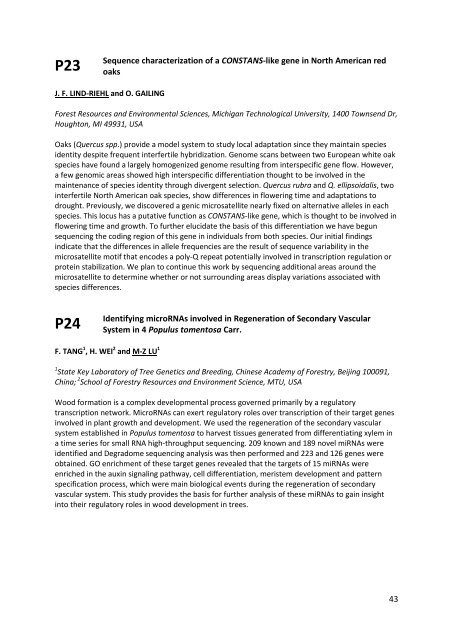Create successful ePaper yourself
Turn your PDF publications into a flip-book with our unique Google optimized e-Paper software.
P23<br />
Sequence characterization of a CONSTANS-like gene in North American red<br />
oaks<br />
J. F. LIND-RIEHL and O. GAILING<br />
Forest Resources and Environmental Sciences, Michigan Technological University, 1400 Townsend Dr,<br />
Houghton, MI 49931, USA<br />
Oaks (Quercus spp.) provide a model system to study local adaptation since they maintain species<br />
identity despite frequent interfertile hybridization. Genome scans between two European white oak<br />
species have found a largely homogenized genome resulting from interspecific gene flow. However,<br />
a few genomic areas showed high interspecific differentiation thought to be involved in the<br />
maintenance of species identity through divergent selection. Quercus rubra and Q. ellipsoidalis, two<br />
interfertile North American oak species, show differences in flowering time and adaptations to<br />
drought. Previously, we discovered a genic microsatellite nearly fixed on alternative alleles in each<br />
species. This locus has a putative function as CONSTANS-like gene, which is thought to be involved in<br />
flowering time and growth. To further elucidate the basis of this differentiation we have begun<br />
sequencing the coding region of this gene in individuals from both species. Our initial findings<br />
indicate that the differences in allele frequencies are the result of sequence variability in the<br />
microsatellite motif that encodes a poly-Q repeat potentially involved in transcription regulation or<br />
protein stabilization. We plan to continue this work by sequencing additional areas around the<br />
microsatellite to determine whether or not surrounding areas display variations associated with<br />
species differences.<br />
P24<br />
Identifying microRNAs involved in Regeneration of Secondary Vascular<br />
System in 4 Populus tomentosa Carr.<br />
F. TANG 1 , H. WEI 2 and M-Z LU 1<br />
1 State Key Laboratory of Tree Genetics and Breeding, Chinese Academy of Forestry, Beijing 100091,<br />
China; 2 School of Forestry Resources and Environment Science, MTU, USA<br />
Wood formation is a complex developmental process governed primarily by a regulatory<br />
transcription network. MicroRNAs can exert regulatory roles over transcription of their target genes<br />
involved in plant growth and development. We used the regeneration of the secondary vascular<br />
system established in Populus tomentosa to harvest tissues generated from differentiating xylem in<br />
a time series for small RNA high-throughput sequencing. 209 known and 189 novel miRNAs were<br />
identified and Degradome sequencing analysis was then performed and 223 and 126 genes were<br />
obtained. GO enrichment of these target genes revealed that the targets of 15 miRNAs were<br />
enriched in the auxin signaling pathway, cell differentiation, meristem development and pattern<br />
specification process, which were main biological events during the regeneration of secondary<br />
vascular system. This study provides the basis for further analysis of these miRNAs to gain insight<br />
into their regulatory roles in wood development in trees.<br />
43



